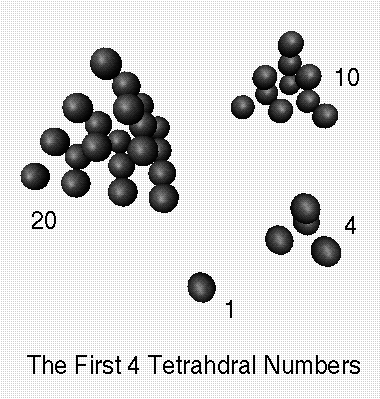
Integers that can be expressed as a tetrahedral array in 3-space. Another charcterization is as the binomial coefficient C(n,4) (for n > 3 ).

An explicit formula for Tn in terms of n is:
Tn = n(n+1)(n+2)/6
A graph formed by a collection of curves in the plane, with the property that the curves corresponding to any pair of edges meet in a single point, which is either an endpoint of both edges or a place where the two curves cross. Every planar straight line graph thrackle has at most as many edges as vertices; Conway's thrackle conjecture states that this is true even for curved thrackles.
In general, transitivity is a property of a relation: if whenever a~b and b~c , then a~c , the relation is transitive. Equality is a transitive relation, so is (set-wise) containment.
In group theory, when a group has a permutation action on a set, the action is called transitive if there are group elements whose permutation action is to exchange any given pair of elements of the set. Such an action is called doubly-transitive if any two ordered pairs can be exchanged by the permutation action of some group element, triply-transitive if any two ordered triples can be exchanged, etc.
A connected graph having no cycles.
Integers that can be expressed as triangular arrays of dots. Another charcterization is as the binomial coefficient C(n,4) (for n > 3 ).

An explicit formula for the nth triangular number is:
Tn = n(n+1)/2
A simplicial complex covering all of a given region in R^d.
Let t and n be positive integers with t at least equal to 2, and n greater than or equal to t. The maximum number of edges of a graph of order n that doesn't contain a complete subgraph of order t is
![\[ \binom{n}{2} - \sum_{i=1}^{t-1} \binom{n_i}{2} \]](T_1.gif)
where the ni form a partition of n into t-1 parts which are as equal as possible.
Furthermore, the complete (t-1)-partite graph with parts of size n1,n2,...nt-1 is the only graph whose number of edges is equal to the bound above but still doesn't contain a complete subgraph of order t.